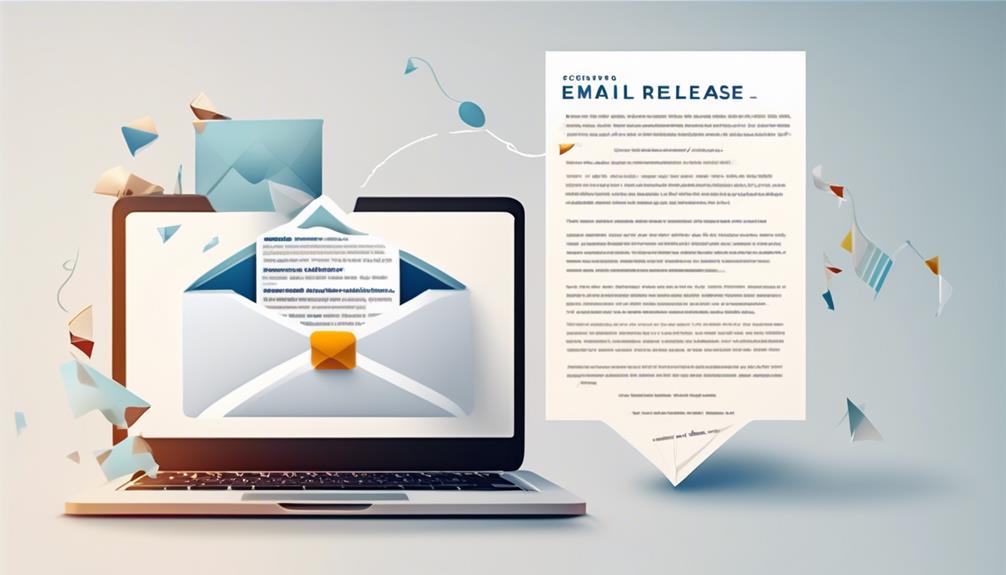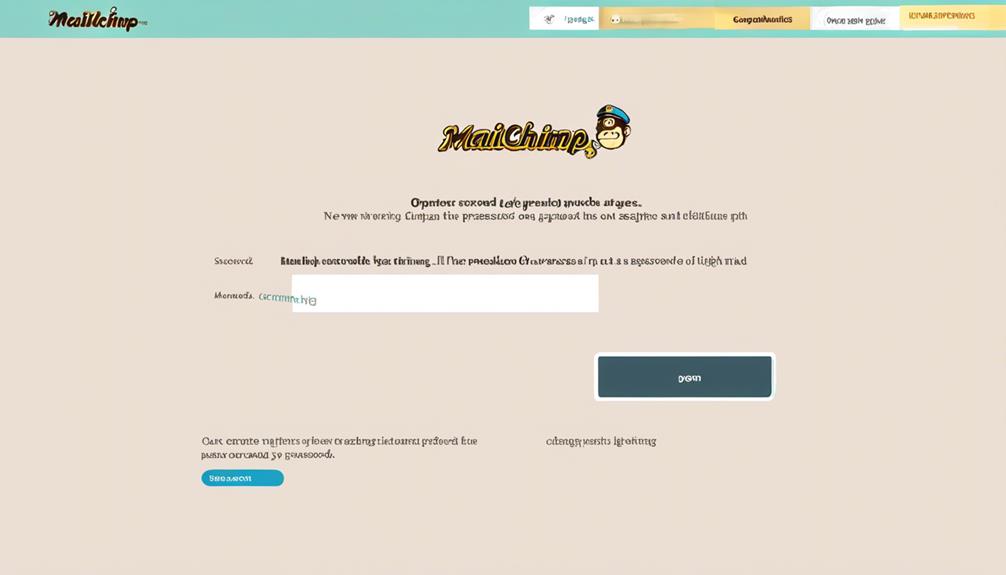Creating a press release email often leads to the dilemma of sounding either too formal or overly informal. Yet, striking the right balance is crucial to grab the attention of reporters and ensure your news is seen.
But how do we strike that balance?
Well, let's just say it involves a mix of creativity and strategic thinking that can make all the difference in the world of media coverage.
Key Takeaways
- Use concise and direct language in the subject line to communicate important information within the first 50-60 characters.
- Personalize the subject line with the recipient's name or mention their previous work.
- Utilize media databases to research journalists who have covered similar topics and target them for your press release.
- Include the press release in the email body or provide a link to avoid triggering spam filters.
Crafting an Engaging Subject Line
Craft an attention-grabbing subject line by using concise and direct language to communicate the most important information within the first 50-60 characters.
When crafting an engaging subject line for a press release email, it's crucial to capture the essence of the news or announcement in a succinct manner.
Journalists receive numerous press release emails daily, so it's essential to make the subject line stand out. Avoid using overly creative or tabloid-style headlines, as these can be off-putting to journalists.
Instead, focus on clearly communicating the pitch and grabbing the journalist's attention. Personalization can also significantly increase open rates, so consider including the recipient's name or mentioning their previous work.
For example, 'New Product Launch: Exclusive Interview Opportunity with [Journalist's Name]' is more likely to catch their eye than a generic subject line.
Remember, the subject line is the first impression, so make it count.
Identifying the Right Journalists

To effectively reach the right journalists for your press release, it's essential to research those who've previously covered similar topics and consider the publications that your target audience follows. When identifying the right journalists for your press release, consider the following:
- Research Journalists: Utilize media databases like Prowly to find journalists who've covered similar topics in the past. Look for their contact details and understand their areas of interest.
- Consider Target Audience Publications: Identify the publications that your target audience follows. This will help you narrow down the list of journalists who are likely to be interested in your press release.
- Utilize Filters: Use filters in media databases to narrow down your search. Filters such as date range, location, and topic can help you find journalists who are a good fit for your press release.
Identifying the right journalists is crucial for ensuring that your press release gets the attention it deserves. By targeting journalists who have a history of covering similar topics and considering the publications your audience follows, you can increase the likelihood of getting media coverage for your press release.
Writing an Effective Press Release Email
When composing an effective press release email, it's crucial to capture the journalist's attention from the outset with a compelling subject line and concise, engaging content. A well-crafted subject line should be attention-grabbing and personalized, highlighting the newsworthiness of the press release.
It's also essential to follow a standard press release format, including a headline, subheader, dateline, body, quote, company info, logo, and media contact information. This ensures that the email is structured and easy to follow, increasing the likelihood of journalists engaging with the content.
Crafting an engaging email to accompany the press release is equally important. The email should be short, captivating, and mention any multimedia or interactive elements included in the release. Additionally, using tools like Grammarly can help spot and correct any errors, ensuring that the email is professional and polished.
When sending a press release via email, it's crucial to research and target the right journalists. This involves identifying their interests and using media databases to find their contact details. By personalizing the email and demonstrating an understanding of the journalist's beat, the press release is more likely to resonate with the recipient, increasing the chances of media coverage.
Including the Press Release in the Email

As we focus on including the press release in the email, it's important to seamlessly connect the captivating content and personalized approach discussed in crafting an effective press release email with the method of presenting the press release angle and key points directly within the email body.
When including the press release in the email, we should:
- Clearly mention the inclusion of the press release in the email body or provide a link for easy access. This ensures that recipients are aware of the press release's presence and can readily access it.
- Keep the email body focused on presenting the press release angle and key points. By doing so, we maintain the reader's attention on the core message without distractions.
- Avoid attaching the press release or adding too many images to prevent triggering spam filters. This helps ensure that the email reaches the intended recipients and doesn't get flagged as spam.
By implementing these strategies, you can increase your chances of the press release being read by relevant journalists. It's also important to consider the preferred methods of receiving press releases by different journalists to maximize the effectiveness of sending press releases via email.
For examples of effectively formatting a press release and press release via email, please refer to the press release examples provided.
Extra Tips for Emailing Press Releases
Implementing extra tips for emailing press releases is crucial for maximizing the impact of our outreach efforts and capturing the attention of journalists.
Firstly, when crafting the email pitch, it's essential to personalize it by addressing the recipient by name and providing a brief introduction to establish a connection.
Additionally, a catchy subject line is vital to convey the most important information and entice the journalist to open the email.
Furthermore, ensure that the press release is in the email body or provide a link to it to avoid triggering spam filters.
When it comes to the press release format, it should be concise and attention-grabbing, with headlines that clearly convey the newsworthiness of the content.
Moreover, it's beneficial to maintain a well-curated list of journalists and news outlets, ensuring that the press release is sent to the most relevant contacts.
Lastly, an informative and compelling follow-up email, sent a few days after the initial pitch, can significantly enhance the chances of coverage.
Frequently Asked Questions
How Do You Write a Good Press Release Email?
We write good press release emails by following a standard format, ensuring newsworthiness, and personalizing the content for the target audience.
We craft engaging subject lines, start with attention-grabbing first sentences, and include essential information using the 5Ws.
Researching journalists who cover similar topics and using tools like Grammarly for error-spotting are crucial.
Our emails are professional, persuasive, and concise, meeting the needs of an audience desiring mastery.
How Do You Write a PR Email?
Sure, we can discuss how to write a PR email.
It's essential to craft a compelling subject line and greeting, personalize the content, and include the 5Ws in the email body.
Avoid spam triggers by minimizing attachments and images.
Always follow the standard press release format and ensure the content is newsworthy and relevant.
A touch of satire can add depth to the writing, making it more engaging and thought-provoking.
How Do You Distribute a Press Release via Email?
We distribute a press release via email by crafting an attention-grabbing subject line and email body, ensuring it's newsworthy and relevant.
We identify and target the right journalists using tools like Prowly and media databases, offering exclusivity and considering their preferred methods of receiving press releases.
We also include personalized introductions and multimedia elements to engage the recipients.
This approach maximizes the impact and reach of our press release.
How Long Should a Press Release Email Be?
We believe that the ideal length for a press release email depends on the content and the journalist's preferences. It's crucial to consider the journalist's time and attention span when crafting the email.
We prioritize keeping the email concise and to the point, while ensuring all essential information is included. Using formatting techniques such as bullet points and subheadings can improve readability and structure.
Clarity and relevance should be prioritized over excessive length when writing a press release email.
Conclusion
In conclusion, writing a press release email is like crafting a love letter to the media. It requires attention to detail, personalization, and a compelling narrative to capture their interest.
By following the standard format, personalizing the email, and following up, we can increase our chances of getting media coverage and publicity.
Just like planting seeds in a garden, nurturing our relationships with journalists can help our stories bloom and grow.









